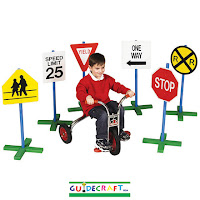Biking is a great outdoor activity for the entire family! When is it feasible to start your toddler on a bike? 2 and 3-year old children are able to start using a tricycle when they
can reach the pedals. Nowadays tricycles
come in a variety of sizes that allow young children to start biking. There are folding tricycles
 |
| Red Folding Tricycle |
 |
| Folds and Stores Easily. Fits in Backseat or Trunk of Car! |
There is a new type of bike for
young children learning to balance and ride called a “strider” or "balance" bike. It is a small bicycle without pedals that
basically lets children learn the skill of balancing on a bike without the
necessity of pedaling.
 |
| Strider or Balance Bike |
Some tricycles are 3-in-1 units, allowing a child to use the toy initially with just their feet, Flintstone-style and then progress to feet on pedals with an adult helping to push and steer, and finally, to propelling the tricycle independently.
 |
| 3-in-1 Bike |
When choosing a bike you should take into consideration the child's size, level of coordination and balance, and motivation. There are four basic
components to learning to ride a bike:
- Ability to place and maintain feet on the bike pedals
- Coordination--the smooth, reciprocal motion of the lower extremities (legs)
- Balance
- Steering
When teaching the components of biking, it is important to
stress Biking Safety as well. It is essential to wear a helmet when biking or participating in other sports
activities where falls are common (skating, skate boarding, etc.). Proper road rules and etiquette should be taught from the very beginning. Learning to stop at stop signs, yield the
right of way, allowing pedestrians the right of way in crosswalks, and staying alert and attentive to surroundings are important skills to keep children and others safe and also serve as building tools for later driving skills.
A fun way to
teach driving rules and safety is to set up a small obstacle course on a driveway, playground, or
bike park. You can use small traffic
cones, pre-made signs, or
cardboard boxes with magic marker symbols. Invite the whole neighborhood to participate!
 |
| Teach Safety and Life Skills in a Fun, Interactive Way! |
Summer is almost here--Get outside and Enjoy a Great Bike Ride whatever your age or Skill level!
See our Blog Post about Strider or Balance Bikes for
starting young children!
Author: Trisha Roberts
www.proeducationaltoys.com
Author: Trisha Roberts
www.proeducationaltoys.com
Copyright © 2016 TNT Inspired Enterprise, LLC,
All rights reserved.
Unauthorized duplication is a violation of
applicable laws.

My grandson just got a balance bike and loves it! He is only three and can zoom all over the park! I am very impressed. Great article, Trisha.
ReplyDelete